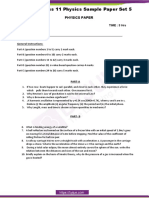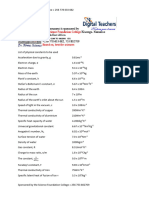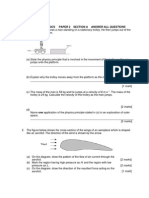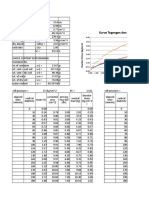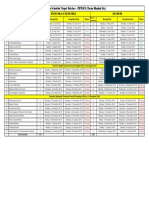Class 11 Physics
Class 11 Physics
Uploaded by
Ansar AhmadCopyright:
Available Formats
Class 11 Physics
Class 11 Physics
Uploaded by
Ansar AhmadCopyright
Available Formats
Share this document
Did you find this document useful?
Is this content inappropriate?
Copyright:
Available Formats
Class 11 Physics
Class 11 Physics
Uploaded by
Ansar AhmadCopyright:
Available Formats
NEW PIONEER COACHING CENTER, NANPARA
Final Term Exam 2024
Class XI Physics
Time: 3 hrs M.M. 100
_________________________________________________________________________
Note: Attempt all the questions.
1. MCQS [2x6=12]
(a) The formula of momentum (p) is….
1 1
(i) 𝑝 = 𝑚𝑣 (ii) 𝑝 = 𝑚𝑣 2 (iii) 2 𝑝 = 𝑚𝑣 2 (iv) 𝑝 = 2 𝑚𝑣 2
(b) Static friction is …..
(i) greater than kinetic friction (ii) lesser than kinetic friction
(iii) lesser than rolling friction (iv) equal to rolling friction
(c) The work done against gravity in lifting 5 kg mass at 2m height in/sec is:
(i) 10 J (ii) 98 J (iii) 9.8 J (iv) 0 J
(d) Which state of matter has volume elasticity?
(i) solid (ii) liquid (iii) gas (iv) all of these
(e) The pressure exerted by water column of 2500 m at its base is (density of water is = 103 kg m-3
and g = 9.8 ms-2 )
(i) 2.0 x 107 N/m2 (ii) 2.5 x 107 N/m2 (iii) 2.45 x 107 N/m2 (iv) 2.55 x 107 N/m2
(f) The thermal conductivity:
(i) of oils decreases with rise of temperature.
(ii) of alloys increases with rise of temperature.
(iii) of water increases with rise of temperature
(iv) all of above are correct.
2. Very Short Answer Type Questions (A): [2x6=12]
(a) State the Galileo’s law of inertia.
(b) Define Newton’s third law of motion.
(c) What will be the work done in holding a weight of a body 10 kg while standing on the road?
(d) Write the statement of Hook’s law.
(e) What is pressure?
(f) What is the melting and boiling points of ice and water respectively in 0F?
3. Very Short Answer Type Questions (B) : [3x4=12]
(a) A constant force is acting on a body of mass 3.0 kg changes its speed form 2.0 ms-1 to 3.5 ms-1 in
25 s. The direction of body remains unchanged. What is the magnitude and direction of the force?
(b) Give two examples where force is applied but no work is done.
(c) Define stress and strain of a body.
(d) State the conditions under which real gases approach ideal gas behaviour? Explain.
4. Short Answer Type Question (A): [4x5=20]
(a) State and explain work energy theorem.
(b) A ball of mass 0.2 kg is thrown vertically upwards with a speed of 15 ms-1 . Calculate the kinetic
and potential energies after one second.
(c) A square lead slab of side 50 cm and thickness 10 cm is
subject to a shearing force (on its narrow face) of 9.0 x 104 N.
The lower edge is reverted to the floor. How much will
the upper edge be displaced?
(d) Explain shear modulus.
(e) Illustrate hydro static paradox.
5. Short Answer Type Question (B): [4x5=20]
(a) Define the following term :
(i) Specific Heat Capacity (ii) Calorimetry
(b) A blacksmith fixes iron ring on the rim of the wooden wheel of a horse cart. The diameter of the
rim and the iron ring are 5.243 m and 5.231 m, respectively at 27 °C. To what temperature should the
ring be heated so as to fit the rim of the wheel?
(c) What is thermal Equilibrium? Explain.
(d) Write a short note on behavior of gases.
(e) List various assumptions of kinetic theory of gases.
6. Long Answer Type Questions: [6x4=24]
(a) Derive Bernouli’s Equation.
OR
Explain variation of pressure in a fluid with depth.
(b) Explain gravitational potential energy and derive its formula.
OR
Explain the following terms:
(i) Linier expansion. (ii) Superficial expansion. (iii) Volume expansion.
(c) Give the magnitude and direction of the net force acting on
(i) a drop of rain falling down with a constant speed,
(ii) a cork of mass 10 g floating on water,
(iii) a kite skillfully held stationary in the sky,
(iv) a car moving with a constant velocity of 30 km/h on a rough road,
(v) a high-speed electron in space far from all material objects, and free of
electric and magnetic fields.
OR
A pebble of mass 0.05 kg is thrown vertically upwards. Give the direction
and magnitude of the net force on the pebble,
(i) during its upward motion,
(ii) during its downward motion,
(iii) at the highest point where it is momentarily at rest. Do your answers
change if the pebble was thrown at an angle of 45° with the horizontal
direction?
Ignore air resistance
(e) State first Law of thermodynamics and its limitations.
OR
Define power and energy. How work done is related with power.
You might also like
- 4.GSA ModellingDocument5 pages4.GSA Modelling8986103tNo ratings yet
- Physics Paper NovDocument6 pagesPhysics Paper NovSANKET MEHTANo ratings yet
- ExamDocument8 pagesExamvineett612No ratings yet
- Year Question PaperDocument43 pagesYear Question Papernithusree2009No ratings yet
- First Term Exam Physics QDocument3 pagesFirst Term Exam Physics Qsolankimayank1322No ratings yet
- KISA Physics QP 2024 Set2Document6 pagesKISA Physics QP 2024 Set2dashrathrai17100% (2)
- Namma Kalvi 11th Physics Public Exam Question Papers English Medium 221432Document24 pagesNamma Kalvi 11th Physics Public Exam Question Papers English Medium 221432Real RemaNo ratings yet
- Class 11 Physics-1Document3 pagesClass 11 Physics-1Mask Man LifeNo ratings yet
- SeeeDocument7 pagesSeeeananya bhadauriaNo ratings yet
- Physics Questions Vol-Ii Bernard PDF PDFDocument2 pagesPhysics Questions Vol-Ii Bernard PDF PDFSilva scary svNo ratings yet
- S6 Mock 2019 Physics P1-1Document7 pagesS6 Mock 2019 Physics P1-1reagantumusiime4No ratings yet
- Physics - Class 9TH - 2018 Past Papers Lahore Board G1 and G2Document13 pagesPhysics - Class 9TH - 2018 Past Papers Lahore Board G1 and G2SYED salman saeedNo ratings yet
- Model Set C (2080)Document5 pagesModel Set C (2080)gautamraman444No ratings yet
- Class 11 Physics - HF 2024Document2 pagesClass 11 Physics - HF 2024Ansar AhmadNo ratings yet
- Seeta S6 Seminar Questions PDFDocument9 pagesSeeta S6 Seminar Questions PDFayikoyoroy10No ratings yet
- Physics Questions (A Level)Document4 pagesPhysics Questions (A Level)ojilongNo ratings yet
- Shack Pre-Mock Examinations 2016 P510/1 Physics Paper 1Document9 pagesShack Pre-Mock Examinations 2016 P510/1 Physics Paper 1EfrataNo ratings yet
- Class 11 Pre Annual Physics Set 1 QPDocument8 pagesClass 11 Pre Annual Physics Set 1 QPSanjukta ChandaNo ratings yet
- Physics 1st Year Full BookDocument3 pagesPhysics 1st Year Full BookMukhtar AhmedNo ratings yet
- 1st Half Book, PhysicsDocument3 pages1st Half Book, PhysicsFast ComputersNo ratings yet
- CBSE Class 11 Physics Sample Paper Set 5Document3 pagesCBSE Class 11 Physics Sample Paper Set 5Prajin MuruganNo ratings yet
- UACE Physics Paper 1 Set9Document5 pagesUACE Physics Paper 1 Set9benzjulius8No ratings yet
- Rubaga Girls' Secondary School: P 510/1 Physics July 2016Document9 pagesRubaga Girls' Secondary School: P 510/1 Physics July 2016esebabiNo ratings yet
- Final Question Paper 11 Sun RiseDocument6 pagesFinal Question Paper 11 Sun RiseOne WorldNo ratings yet
- Part-I Test Question Physics General English VersionDocument4 pagesPart-I Test Question Physics General English VersionsajalkwcNo ratings yet
- Physics 9thDocument2 pagesPhysics 9thwaleedpt7No ratings yet
- Success Key Test Series Subject: Physics: Annual ExaminationDocument4 pagesSuccess Key Test Series Subject: Physics: Annual ExaminationBhavesh AsapureNo ratings yet
- Prehalf 11Document4 pagesPrehalf 11SVVV MANAGEMENT CLPNo ratings yet
- Objective PhysicsDocument4 pagesObjective PhysicsleoyodapieNo ratings yet
- Section A Physics Paper 1 Mechanics Revision Questions For A LevelDocument29 pagesSection A Physics Paper 1 Mechanics Revision Questions For A Levelalemorgan418No ratings yet
- Set Physics Paper 2 Section A Answer All QuestionsDocument9 pagesSet Physics Paper 2 Section A Answer All QuestionsUmie HakimieNo ratings yet
- MT XI SECTION B AND C (2)Document2 pagesMT XI SECTION B AND C (2)techbrohi828No ratings yet
- GR 9 ICSE Final Exam Question Paper PhysicsDocument4 pagesGR 9 ICSE Final Exam Question Paper PhysicsanjalimenonNo ratings yet
- Physics F IIIADocument2 pagesPhysics F IIIAAZORYNo ratings yet
- Final Model Paper Physics SSC-IDocument7 pagesFinal Model Paper Physics SSC-Iacumensales01No ratings yet
- R.K. Memorial Education Centre: Half Yearly Examination 2022-23 Subject-Physics Class-10 M.M. - 80Document4 pagesR.K. Memorial Education Centre: Half Yearly Examination 2022-23 Subject-Physics Class-10 M.M. - 80mishraamitesh28No ratings yet
- Physics 1st YearDocument2 pagesPhysics 1st YearRashid Jalal100% (1)
- S5 Phy 1 End of Term2Document5 pagesS5 Phy 1 End of Term2hope33061No ratings yet
- Physics Part-I 1st Half (1-6) bDocument3 pagesPhysics Part-I 1st Half (1-6) bkami.ansari107No ratings yet
- A Level Seminar ReadyDocument16 pagesA Level Seminar ReadyOnesmus GumisirizaNo ratings yet
- TestDocument10 pagesTestSIMPINo ratings yet
- Xi-Sci Phy Annual ExamDocument3 pagesXi-Sci Phy Annual ExamAlokNo ratings yet
- Sample Paper On Physics Grade 10Document3 pagesSample Paper On Physics Grade 10aadesh_mahatoNo ratings yet
- SELECTION X PHYSICS 23-24 - NewDocument7 pagesSELECTION X PHYSICS 23-24 - NewJotham SolomonNo ratings yet
- Mock 2023Document8 pagesMock 2023kinene richardNo ratings yet
- A Level Physics Seminar 2024 MechanicsDocument20 pagesA Level Physics Seminar 2024 Mechanicsisaacssemakula90100% (1)
- Sample Paper +1 Physics 16.01.23Document3 pagesSample Paper +1 Physics 16.01.23upendrsharma66No ratings yet
- Semester Test: 124.102 - PHYSICS 1 (B)Document5 pagesSemester Test: 124.102 - PHYSICS 1 (B)xfriendly11No ratings yet
- Icjephpu 13Document13 pagesIcjephpu 13Sharique SyedNo ratings yet
- s6 Physics Paper 1 Mock Exam 2020 St. Mary039s KitendeDocument8 pagess6 Physics Paper 1 Mock Exam 2020 St. Mary039s KitendepeterpaknNo ratings yet
- PHY1DA1Document3 pagesPHY1DA1mphomogopudi05No ratings yet
- Namugongo A' Level Physics Seminar 2023Document18 pagesNamugongo A' Level Physics Seminar 2023abelcbucks06No ratings yet
- S5phy1eotii2024-Pmss 045022Document4 pagesS5phy1eotii2024-Pmss 045022JOSEPH KUSIIMANo ratings yet
- 11th Physics EM Half Yearly Exam 2023 Question Paper Virudhunagar District English Medium PDF DownloadDocument2 pages11th Physics EM Half Yearly Exam 2023 Question Paper Virudhunagar District English Medium PDF Downloadselvitamil217No ratings yet
- Physics Theory and Practics S1Document24 pagesPhysics Theory and Practics S1nanastase41No ratings yet
- F4 Full Package PDFDocument145 pagesF4 Full Package PDFPAMAJANo ratings yet
- Physiiroko Community Grammer Schoolss2Document3 pagesPhysiiroko Community Grammer Schoolss2ogunfunminiyiestherNo ratings yet
- Physics: Uace Mock Examinations 2015 Physics Paper 1 2 Hours 30 MinDocument5 pagesPhysics: Uace Mock Examinations 2015 Physics Paper 1 2 Hours 30 MinKitone A NdrewNo ratings yet
- Class 11 Physics Annual QP 2023-24Document6 pagesClass 11 Physics Annual QP 2023-24karthika.rvNo ratings yet
- Class XI Physics SP SET 1Document4 pagesClass XI Physics SP SET 1Dhivya.k Dhivya.kNo ratings yet
- نموذج حصر حديد تسليح القواعد المنفصلةDocument3 pagesنموذج حصر حديد تسليح القواعد المنفصلةasemelsawy70No ratings yet
- Friction in An Inclined SurfaceDocument7 pagesFriction in An Inclined SurfaceADELA PEREZ CARREÑONo ratings yet
- 8th ICSE Physics Test - Pressure and Archimedes PrincipleDocument2 pages8th ICSE Physics Test - Pressure and Archimedes PrinciplemanojboaNo ratings yet
- 7 EXERCISE 4 - CompleteDocument6 pages7 EXERCISE 4 - CompleteQusai SaifyNo ratings yet
- GravitationDocument7 pagesGravitationRaju SinghNo ratings yet
- Mathematical Literacy Grade 11 Term 2 Week 6 - 2020Document10 pagesMathematical Literacy Grade 11 Term 2 Week 6 - 2020Mahlatse Mashiane100% (1)
- Kurva Tegangan Dan Regangan: Strain (%)Document8 pagesKurva Tegangan Dan Regangan: Strain (%)Anna DestNo ratings yet
- MIT8 223IAP17 ProjectPart2Document7 pagesMIT8 223IAP17 ProjectPart2Fake NooneNo ratings yet
- Physics Lecture Schedule (Target Batches)Document1 pagePhysics Lecture Schedule (Target Batches)Tarun MankadNo ratings yet
- Applied Mechanics I - Spring 2013Document5 pagesApplied Mechanics I - Spring 2013RajeshGupta0% (1)
- SEMI-DETAILED LESSON PLAN FORMAT Week 3Document6 pagesSEMI-DETAILED LESSON PLAN FORMAT Week 3Michael Clyde GurdielNo ratings yet
- Atwood Lab ReportDocument4 pagesAtwood Lab Reportapi-255054797No ratings yet
- Chapter - 4 Motion in A PlaneDocument15 pagesChapter - 4 Motion in A PlaneTrilok AkhaniNo ratings yet
- Project 02: Simple Slope Static and Dynamic AnalysisDocument13 pagesProject 02: Simple Slope Static and Dynamic AnalysisJason YudhaNo ratings yet
- Lab 11Document5 pagesLab 11KrishnanNo ratings yet
- Notes05 - Applications of Newtion's LawsDocument44 pagesNotes05 - Applications of Newtion's LawssamNo ratings yet
- Laone ReportDocument22 pagesLaone ReportLaone DiauNo ratings yet
- (L4) Electrostatics - 20 April NotesDocument33 pages(L4) Electrostatics - 20 April NotesAyush Kumar MishraNo ratings yet
- Density and Buoyancy EssayDocument2 pagesDensity and Buoyancy Essayapi-250545038No ratings yet
- Gauss' Law PDFDocument22 pagesGauss' Law PDFPaul BryanNo ratings yet
- Homework 3Document7 pagesHomework 3Ale Gomez100% (5)
- Classical Mechanics Spring 2021: Daniel K. Mark August 16, 2021Document5 pagesClassical Mechanics Spring 2021: Daniel K. Mark August 16, 2021Karishtain NewtonNo ratings yet
- Lesson Plan: Subject Science Class - Viii No. of Periods Required: 5Document1 pageLesson Plan: Subject Science Class - Viii No. of Periods Required: 5Manpreet KaurNo ratings yet
- Module 4-I, V, R and Ohms LawDocument10 pagesModule 4-I, V, R and Ohms Lawkylie jonesNo ratings yet
- ELECTRO STATICS Practice ProblemsDocument26 pagesELECTRO STATICS Practice Problemsdenunderligeran100% (1)
- 20151123131113lecture 10 - Angular KineticsDocument3 pages20151123131113lecture 10 - Angular KineticsmanrunnerNo ratings yet
- Stage 2 Biomechanics 2nd Ed Sample PackageDocument13 pagesStage 2 Biomechanics 2nd Ed Sample PackagegundadanNo ratings yet
- Potential Energy and Conservation of EnergyDocument16 pagesPotential Energy and Conservation of EnergyzakNo ratings yet
- Tutorial 1 With SolutionsDocument18 pagesTutorial 1 With SolutionsFlancNo ratings yet




















